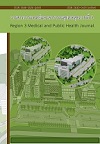ประสิทธิภาพการใช้ fecal immunochemical test ในการตรวจคัดกรองมะเร็งลำไส้ใหญ่และไส้ตรง โดยเปรียบเทียบค่า cut-off ที่ 50 นาโนกรัมต่อมิลลิลิตร และ 100 นาโนกรัมต่อมิลลิลิตร
คำสำคัญ:
มะเร็งลำไส้ใหญ่และไส้ตรง, การตรวจคัดกรองมะเร็งลำไส้ใหญ่และไส้ตรง, fecal immunochemical test (FIT test), cut-off value, ค่าทำนายผลบวกและค่าทำนายผลลบบทคัดย่อ
วัตถุประสงค์ : เพื่อเปรียบเทียบอัตราการตรวจพบเนื้องอกขั้นสูง (advanced adenoma) และมะเร็งลำไส้ใหญ่และไส้ตรง (colorectal cancer) ในผู้ป่วย fecal immunochemical test (FIT test) positive ที่ใช้ค่า cut-off ที่ต่างกันโดยใช้ค่าทำนายผลบวก (positive predictive value : PPV) กำหนด และเพื่อหาค่า cut-off ที่เหมาะสม
วิธีการศึกษา : ศึกษาเชิงวิเคราะห์ชนิดย้อนหลัง กลุ่มตัวอย่างคือผู้ที่ได้รับการตรวจ FIT test positive จากโรงพยาบาลทั้ง 8 แห่งในจังหวัดอุทัยธานีและได้รับการส่องกล้องลำไส้ใหญ่ (colonoscopy) ที่โรงพยาบาลอุทัยธานี ตั้งแต่ปีงบประมาณ 2561 ถึง 2563 มีอายุระหว่าง 45 ถึง 75 ปี แบ่งกลุ่มตัวอย่างเป็น 2 กลุ่ม คือกลุ่มที่ 1 FIT test positive โดยใช้ cut-off ที่ 100 นาโนกรัมต่อมิลลิลิตร จำนวน 159 คน และกลุ่มที่ 2 FIT test positive โดยใช้ cut-off ที่ 50 นาโนกรัมต่อมิลลิลิตร จำนวน 159 คน
ผลการศึกษา: กลุ่มตัวอย่างเป็นเพศหญิงมากที่สุดทั้ง 2 กลุ่ม ร้อยละ 62.9 และร้อยละ 55.3 อายุเฉลี่ย 60.4±5.8 ปี ในกลุ่มที่ 1 และ 60.9±9.6 ปี ในกลุ่มที่ 2 โดยลักษณะทั่วไปทั้ง 2 กลุ่มไม่มีความแตกต่างกัน ยกเว้นค่าดัชนีมวลกาย และโรคประจำตัวอื่นๆ พบเนื้องอกขั้นสูงและมะเร็งลำไส้ใหญ่และไส้ตรง ร้อยละ 3.8 ในกลุ่มที่ 1 FIT test positive cut-off ที่ 100 นาโนกรัมต่อมิลลิลิตร และร้อยละ 20.1 ในกลุ่มที่ 2 FIT test positive cut-off ที่ 50 นาโนกรัมต่อมิลลิลิตร พบว่า FIT test positive cut-off ที่ 100 นาโนกรัมต่อมิลลิลิตรมี sensitivity ร้อยละ 100.0, specificity ร้อยละ 64.1, PPV ร้อยละ 9.8, negative predictive value (NPV) ร้อยละ 100.0 และ false positive rate ร้อยละ 35.9 และ FIT test positive cut-off ที่ 50 นาโนกรัมต่อมิลลิลิตร มี sensitivity ร้อยละ 100.0, specificity ร้อยละ 48.0, PPV ร้อยละ 32.7, NPV ร้อยละ 100.0 และ false positive rate ร้อยละ 51.9 กลุ่ม FIT test positive cut-off ที่ 50 นาโนกรัมต่อมิลลิลิตรร่วมกับมีอาการแสดง มีโอกาสพบเนื้องอกขั้นสูงและมะเร็งลำไส้ใหญ่และไส้ตรงมากกว่ากลุ่มที่ไม่มีอาการแสดง 11.74 เท่า อย่างมีนัยสำคัญทางสถิติ (OR=11.74, 95%CI 1.54-89.32, P value <0.01) นอกจากนี้มี sensitivity ร้อยละ 100.0 specificity ร้อยละ 48.9, PPV ร้อยละ 38.9, NPV ร้อยละ 100.0 และ false positive rate ร้อยละ 51.1 เมื่อพิจารณาในกลุ่มที่ไม่มีอาการแสดงพบว่า ในกลุ่มที่ 1 FIT test positive cut-off ที่ 100 นาโนกรัมต่อมิลลิลิตร มี sensitivity ร้อยละ 100.0, specificity ร้อยละ 64.3, PPV ร้อยละ 11.5, NPV ร้อยละ 100.0 และ false positive rate ร้อยละ 35.7 และในกลุ่มที่ 2 FIT test positive cut-off ที่ 50 นาโนกรัมต่อมิลลิลิตร มี sensitivity ร้อยละ 100.0, specificity ร้อยละ 45.0, PPV ร้อยละ 9.5, NPV ร้อยละ 100.0 และ false positive rate ร้อยละ 54.3 พบว่าเมื่อค่า cut-off ลดลง ค่า specificity และค่า PPV ลดลงเช่นกัน
สรุป : FIT test positive cut-off ที่ 100 นาโนกรัมต่อมิลลิลิตร จะมี specificity และ PPV สูงกว่าการใช้ FIT test positive cut-off ที่ 50 นาโนกรัมต่อมิลลิลิตรสำหรับกลุ่มเสี่ยงที่ไม่มีอาการแสดงในการคัดกรองมะเร็งลำไส้ใหญ่และไส้ตรงรวมทั้งเนื้องอกขั้นสูงของลำไส้ใหญ่ที่มีโอกาสเป็นมะเร็งต่อไปในอนาคตได้ นอกจากนี้ยังมี false positive rate น้อยกว่า ทำให้ลดการส่องกล้องลำไส้ใหญ่โดยไม่จำเป็นได้ สำหรับกลุ่มเสี่ยงที่มีอาการแสดงร่วมด้วยสามารถใช้ FIT test positive cut-off ที่ 50 นาโนกรัมต่อมิลลิลิตรในการคัดกรองมะเร็งลำไส้ใหญ่และไส้ตรงได้ เนื่องจากมี PPV สูงกว่า เพื่อนำไปพิจารณาส่องกล้องลำไส้ใหญ่ต่อไป
คำสำคัญ : มะเร็งลำไส้ใหญ่และไส้ตรง, การตรวจคัดกรองมะเร็งลำไส้ใหญ่และไส้ตรง, fecal immunochemical test (FIT test), cut-off value, ค่าทำนายผลบวกและค่าทำนายผลลบ
เอกสารอ้างอิง
Imsamran W, Pattatang A, Supaattagorn P, Chiawiriyabunya I, Namthaisong K, Wongsena M, et al. Cancer in Thailand volume IX, 2013-2015. Bangkok: Ministry of Public Health ;2018.
Laohavinij S, Maneechavakajorn J,Techatanol P. Prognostic factors for survival in colorectal cancer patients. J Med Assoc Thai. 2010, 93(10):1156-66.
Rex DK, Johnson DA, Anderson JC, Schoenfeld PS, Burke CA, Inadomi JM. American College of Gastroenterology guidelines for colorectal cancer screening 2009 [corrected]. Am J Gastroenterol 2009;104(3):739-50. doi: 10.1038/ajg.2009.104.
Young GP, Symonds EL, Allison JE, Cole SR, Fraser CG, Halloran SP, et al. Advances in fecal occult blood tests: the FIT revolution. Dig Dis Sci 2015;60(3):609-22. doi: 10.1007/s10620-014-3445-3.
Lin JS, Piper MA, Perdue LA, Rutter CM, Webber EM, O’Connor E, et al. Screening for colorectal cancer: updated evidence report and systematic review for the US Preventive Services Task Force. Jama 2016;315(23):2576-94. doi: 10.1001/jama.2016.3332.
Sung JJ, Ng SC, Chan FK, Chiu HM, Kim HS, Matsuda T, et al. An updated Asia Pacific Consensus Recommendations on colorectal cancer screening. Gut 2015;64(1):121-32. doi: 10.1136/gutjnl-2013-306503.
Bresalier RS. Early detection of and screening for colorectal neoplasia. Gut Liver 2009;3(2):69–80. doi: 10.5009/gnl.2009.3.2.69.
Hamilton SR, Vogelstein B, Kudo S, Riboli E, Nakamura S, Hainaut P, et al. Tumours of the colon and rectum. In: Hamilton SR, Aaltonen LA, editors. World Health Organization classification of tumours. Pathology and genetics of tumours of the digestive system. 4th ed. Lyon, France: IARC Press; 2000. p. 104.
Hiraoka S, Kato J, Fujiki S, Kaji E, Morikawa T, Murakami T, et al. The presence of large serrated polyps increases risk for colorectal cancer. Gastroenterology 2010;139(5): 1503-10–1510.e1-3.
Levy BT, Bay C, Xu Y, Daly JM, Bergus G, Dunkelberg J, et al. Test characteristics of fecal immunochemical tests (FIT) compared with optical colonoscopy. J Med Screen 2014 Sep;21(3):133-43.
Salimzadeh H, Bishehsari F, Sauvaget C, Amani M, Hamzehloo G, Nikfarjam A, et al. Feasibility of colon cancer screening by fecal immunochemical test in Iran. Arch Iran Med.2017;20(12):726-33.
Aniwan S, Ratanachu-Ek T, Pongprasobchai S, Limsrivilai J, Praisontarangkul A, Pisespongsa P, et al. The optimal cut-off level of the fecal immunochemical test for colorectal cancer screening in a country with limited colonoscopy resources: a multi-center study from Thailand. Asian Pac J Cancer Prev 2017;18(2):405-12.
de Wijkerslooth TR, Stoop EM, Bossuyt PM, Meijer GA, van Ballegooijen M, van Roon AH, et al. Immunochemical fecal occult blood testing is equally sensitive for proximal and distal advanced neoplasia. Am J Gastroenterol 2012;107:1570-8.
Navarro M, Hijos G, Sostres C, Lue A, Puente-Lanzarote JJ,Carrera-Lasfuentes P, et al. Reducing the cut-off value of the fecal immunochemical test for symptomatic patients does not improve diagnostic performance. Frontiers in Medicine 2020;7:410.
ดาวน์โหลด
เผยแพร่แล้ว
วิธีการอ้างอิง
ฉบับ
บท
การอนุญาต
ลิขสิทธิ์ (c) 2022 เขต3 และโรงพยาบาลสวรรค์ประชารักษ์

This work is licensed under a Creative Commons Attribution-NonCommercial-NoDerivatives 4.0 International License.




